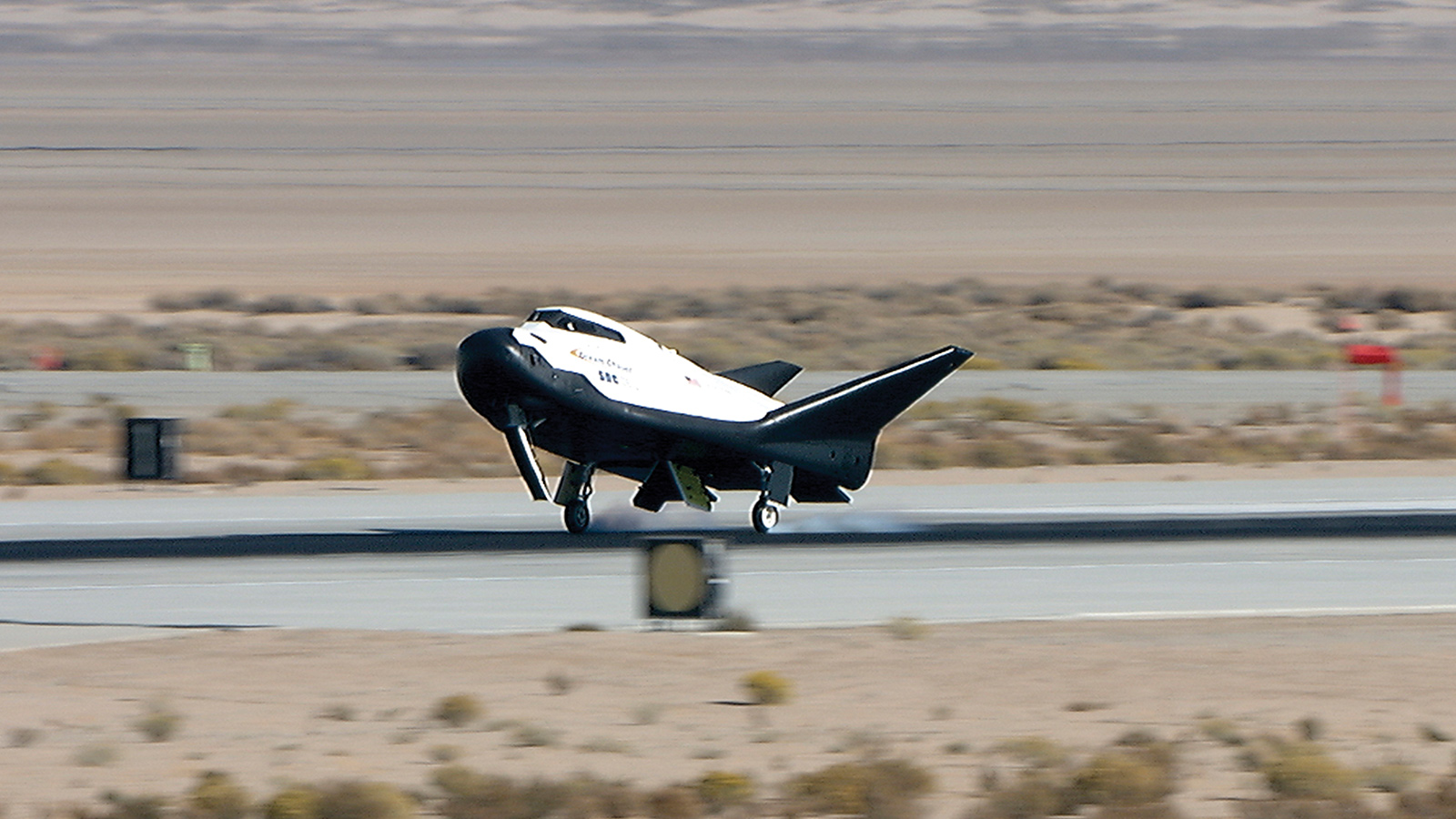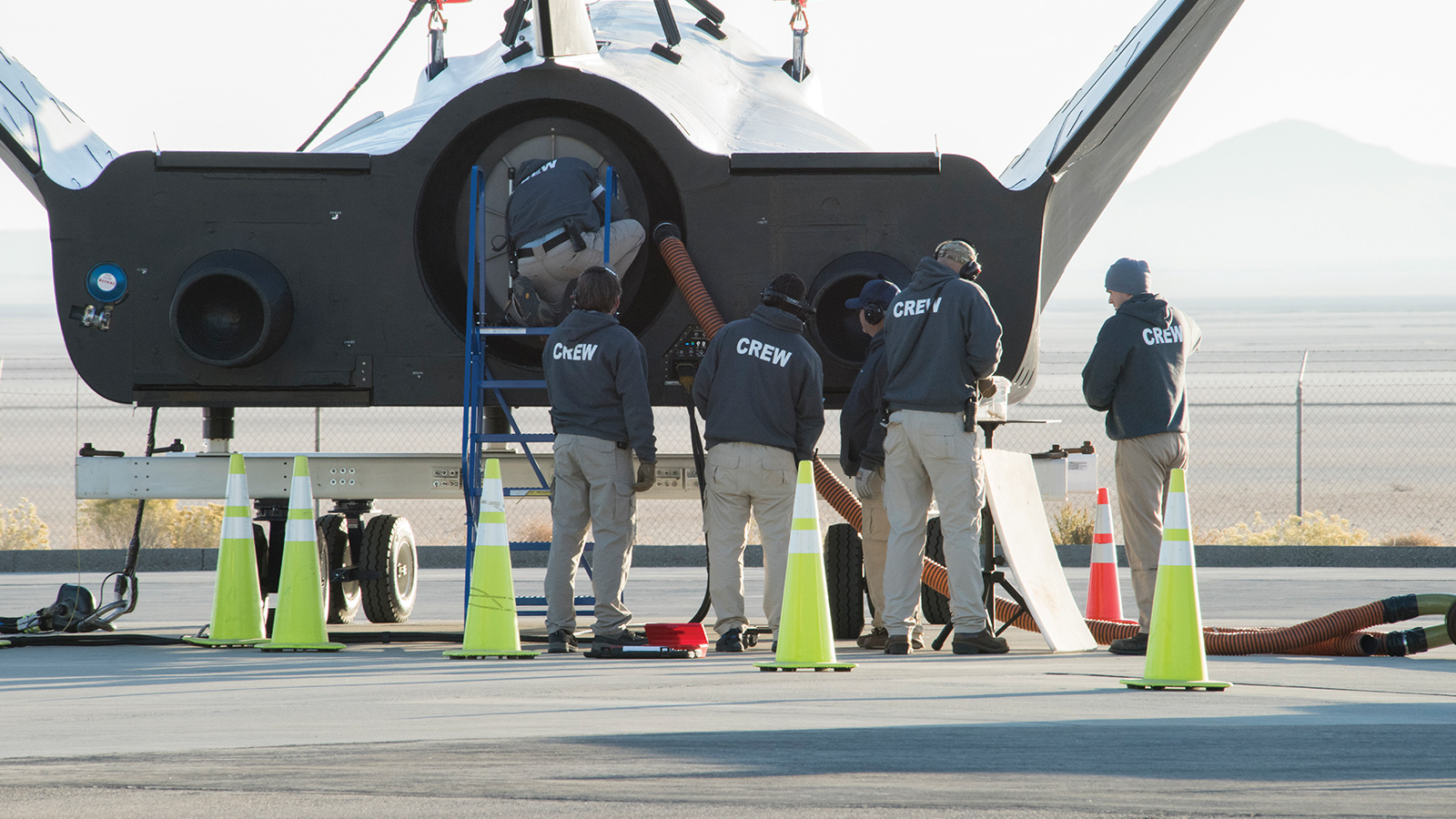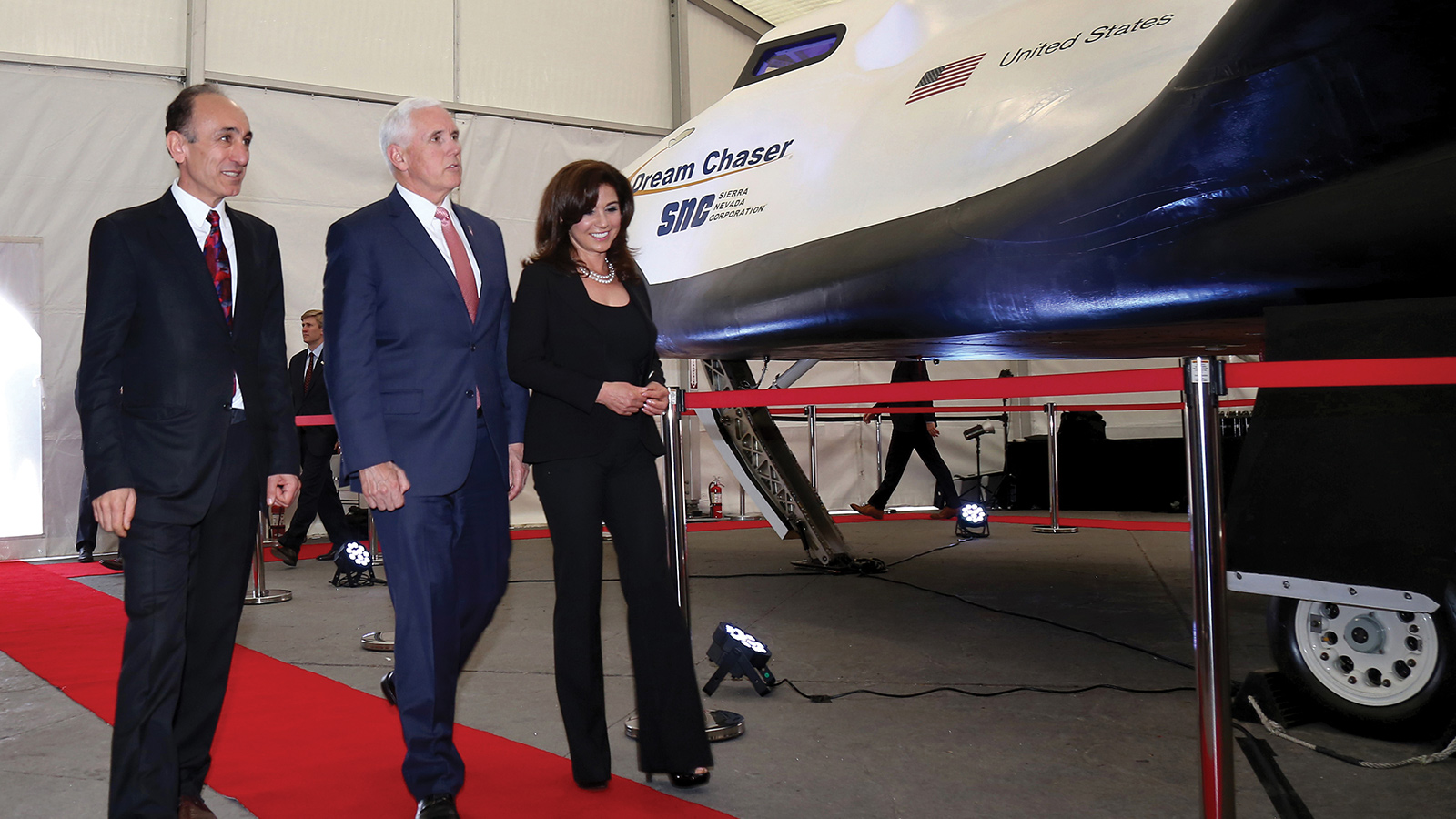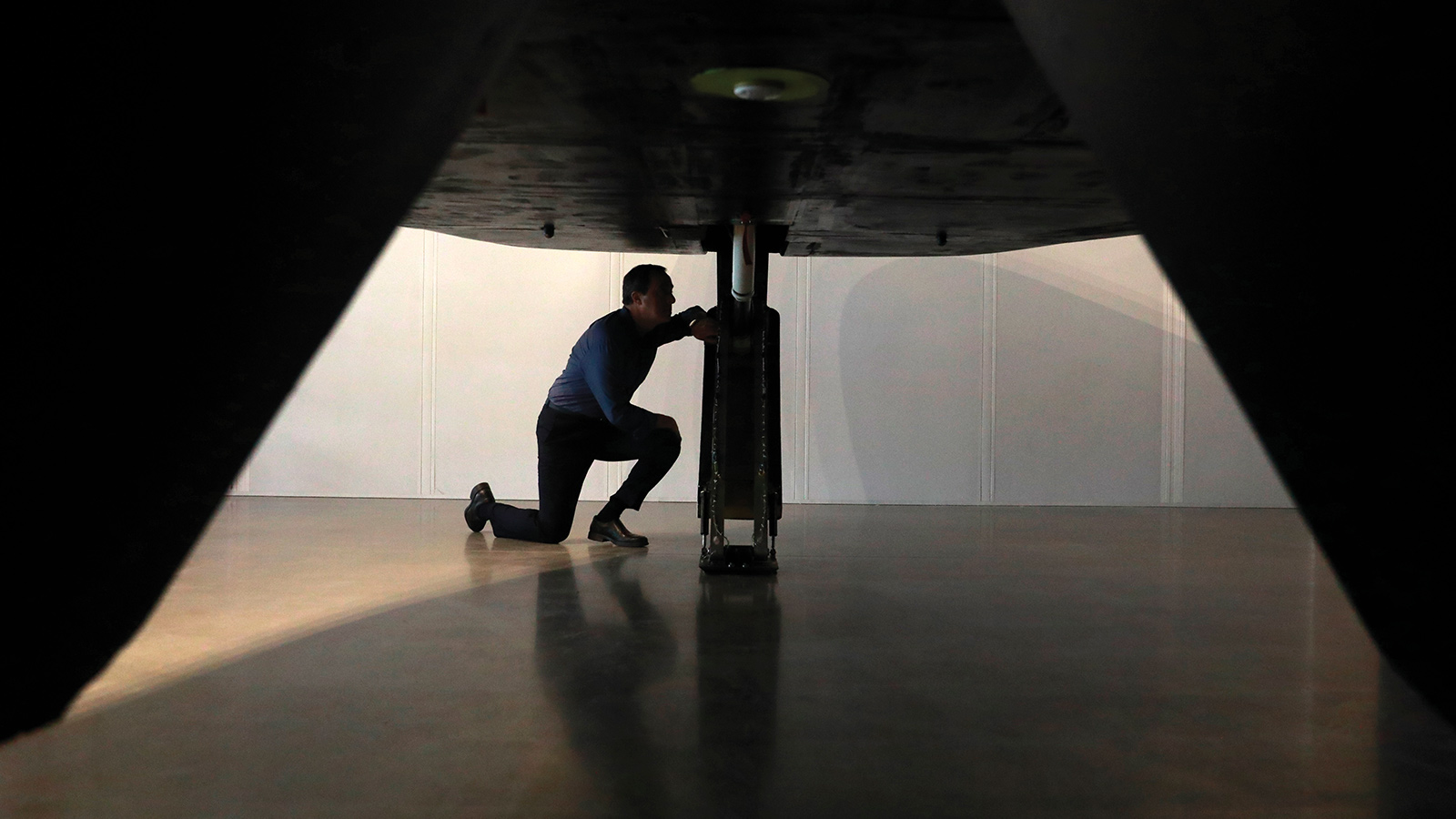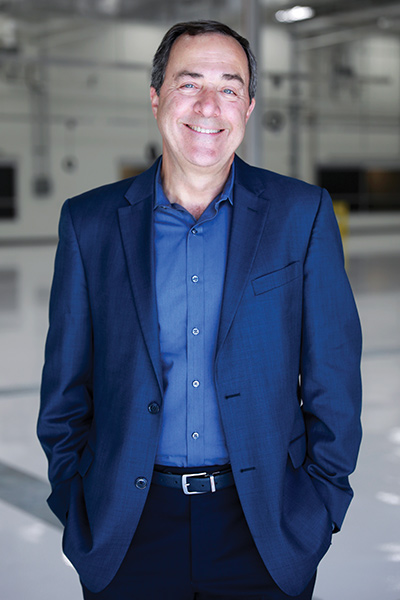Stay Up to Date
Submit your email address to receive the latest industry and Aerospace America news.
If all goes as Sierra Nevada Corp. hopes, you’ll soon be hearing a lot more about Dream Chaser, the spacecraft with a history of ups and downs. Amanda Miller toured the new Colorado facility where the first spaceflight version of Dream Chaser will be built.
The year was 2014. Mark Sirangelo had already made all the mistakes known to entrepreneurs, “some multiple times, just to make sure how bad I could be.”
As head of Sierra Nevada Corp.’s Space Systems division in Colorado, Sirangelo knew NASA was going to call between 8 and 9 a.m. The company that builds satellites and intelligence cameras and modifies aircraft for the military was vying against SpaceX and Boeing Co. for the right to ferry astronauts to and from the International Space Station in a privately owned spacecraft.
Sirangelo had good reasons to be confident about the call, but also a nagging concern. His 200-person team had proposed the only contender that could land on a runway, as the space shuttle fleet had done before its retirement. Not only that, much of Dream Chaser’s design had come from NASA itself. Still, a landing gear malfunction after a helicopter drop test the year before had caused the test version of Dream Chaser to skid off the runway at Edwards Air Force Base, California. The landing wasn’t a requirement of that particular test, and the one-and-only Dream Chaser test vehicle survived to glide again. Even so, the incident probably hadn’t helped the company’s cause.
When the phone call came, the program officer’s words were a lot like the ones Sirangelo wanted to hear, “with one or two really big, important exceptions,” he says. The officer was sorry to say Dream Chaser was not among the two concepts selected to deliver astronauts back and forth.
And the Space Systems division descended into one of the periodic dark chapters in its corporate history.
This is the story of how the Dream Chaser team has climbed out of this pit, with a multibillion-dollar NASA contract on the books and international business in view. Soon, full-scale production will begin on the Dream Chaser Cargo System, while SNC continues to work out the details of a United Nations science mission — the U.N.’s first-ever mission to space.
It’s a business fairytale with sci-fi overtones that can’t help but conjure comparisons to a certain mythical beast: the fabled Egyptian phoenix bird that rose from the flames.
If you’ve poured your heart into a project, only to lose a bid, or you’re staring down the barrel of a business setback that’s going to hurt a lot of people, keep in mind Dream Chaser’s fall, its pending rise, and what that all could symbolize — if everything goes as planned. Ascent and re-entry, after all, are still unproved.
I met with Sirangelo as he counted down his days running the division after nearly a decade in the role. Longer, if you include his time as CEO of the startup SpaceDev, which SNC acquired.
Lesson 1: Take the long view
Our backstory begins in 2001, before Sirangelo had joined SNC. He was at the annual Space Symposium in Colorado Springs where he was being inducted into the Space Technology Hall of Fame as CEO of a company that designed an infrared missile sensor that was developed for medical research.
That symposium reconnected Sirangelo with some people he’d known as a U.S. Army officer when he advised at the Pentagon. Those former colleagues were on the board of “this very small company in San Diego called SpaceDev” that was trying to break into the space industry. They invited him to consult and soon asked him to be CEO and chairman, which he accepted. “And we were in a garage — literally a garage.”
Around 2004 or 2005, in the course of working on a business plan, the small team at SpaceDev recognized that the space shuttle’s days were likely numbered. They asked themselves: “If we were going to rebuild the shuttle now, how would it be different?” Sirangelo recalls.
A lot had changed since the space shuttle was designed in the late 1960s and 1970s. The shuttle orbiters were built big to launch elements of a future space station, scientific spacecraft (most famously the Hubble Space Telescope) and spy satellites. By the mid-2000s, space station assembly was well underway, and national security satellites were traveling on unmanned rockets.
“We thought there needed to be a [space shuttle] 2.0, and there were no plans for a 2.0,” Sirangelo says.
He knew that lots of promising NASA research got relegated to files, never resulting in a product.
“I said, ‘Well, maybe we should go look.’”
Lesson 2: Give “life support” when necessary
NASA had studied an idea for a spacecraft smaller than the space shuttle, known as the HL-20, back in the 1980s to take astronauts to a then-envisioned Space Station Freedom.
In name, the HL-20 alluded to a prior NASA spaceplane design called the HL-10. But the HL-20 was really based on spy photos of a Soviet spaceplane, says John Martin, an engineer at NASA’s Langley Research Center in Virginia who became the point person there for Dream Chaser, sharing all the data and insights that NASA’s engineers had acquired.
The HL-20’s lifting-body design — lift is generated by the spacecraft’s body instead of wings — meant it could land on a runway.
Students from North Carolina State University and North Carolina A&T State University built a full-size research model of the HL-20 for Langley in 1990 to help envision the layout for a 10-member crew.
Several years of study ultimately went into the HL-20 at Langley, but the idea was later axed. Estimates had ranged from $3 billion to $6 billion to build it.
“So we came in, in 2005, and said … ‘Why not start out with something that had 10 years of good work, that wasn’t killed because it was a failure — it was killed for budget reasons and other reasons?’” Sirangelo says.
“And we actually have kept the same shape of the vehicle, through all its turns — it’s called the outer mold line — I mean, within small tolerances. They did it right. They did it well. We changed a lot of other things, but we kept the basic design and shape because it works pretty well.”
Just as SpaceDev rescued the HL-20 mockup from impending destruction — “because it wasn’t being useful for anything, it was going to be destroyed,” Sirangelo says — NASA made what ended up being its own historic maneuver.
NASA started a program in 2005 called COTS, short for Commercial Orbital Transportation Services, allocating an initial $500 million for it. This was the U.S. government’s first step toward seeding commercial space enterprises. The idea of COTS was to get companies working on concepts for carrying cargo and/or crew as a service, rather than NASA picking a company to build a spacecraft to its precise specifications and taking ownership of it.
COTS was effectively a first phase for companies, such as the young SpaceDev, to demonstrate that they could take on space transportation. The company submitted proposals twice and was turned down twice. “We found ourselves being that close to being funded with a reasonable amount of money, a couple hundred million dollars, and we didn’t get it — which created, as you can imagine, a lot of disappointment.”
SpaceX’s reusable Dragon capsule got a funding boost under COTS, as did then-Orbital Science Corp.’s expendable Cygnus capsules, which burn up, along with ISS trash, on re-entry. Cygnus got picked in a second round of proposals, after the now-defunct Rocketplane Kistler company, initially selected — although in bankruptcy at the time — couldn’t fulfill its contract. “We found ourselves having lost two competitions within a year-and-a-half, both of which we thought we should’ve won,” Sirangelo says. “And that led to a very dark period” in which “everyone thought, ‘Well, you had your crazy idea. You tried. You came really close. It’s over.’”
But COTS had forced the Dream Chaser team to get real. They had defined the project. They had found partners. They didn’t want to give up.
“So we kept it on life support for a couple of years on our own,” Sirangelo says, investing the company’s money to continue some of the work — “to prove to ourselves we could actually build and fly the vehicle.”
Lesson 3: Ride the ups and downs
Meanwhile, a fortunate meeting over a contract had connected Sirangelo with Nevada-based Sierra Nevada Corp.’s owners, Eren and Fatih Ozmen. SNC acquired SpaceDev and brought Dream Chaser into the fold.
“At that time, it was enormously innovative to understand that building a successful space program didn’t necessarily have to start from scratch,” says SNC’s CEO and owner Fatih Ozmen. “It was exciting to us that there was no one else building anything like it, even with 30 years of shuttle legacy proving that the design works.”
Then the announcement came down in 2010: The space shuttle fleet would be permanently grounded. NASA soon started its series of Commercial Crew Development contracts as a successor to COTS. Contracts would be awarded to companies for work devising concepts to take astronauts to and from the International Space Station in privately owned spacecraft that would meet NASA’s strict safety criteria.
“We submitted, and this whole long, dark period shut off, and we won the biggest of the contracts,” Sirangelo says. “And all our craziness began to look not so crazy.”
SNC won four Commercial Crew Development contracts in all, for a total of $363.1 million, to design and build the Dream Chaser test vehicle, the same craft that ran off the runway in the unmanned test at Edwards in 2013 and that completed its last test flight in November 2017.
The earlier landing-gear malfunction was traced to a possible clog in the hydraulics. Dream Chaser had sat locked behind the gates at Edwards throughout a three-week government shutdown.
“One of the things no one had ever anticipated was a three-week stand-down, because of a government shutdown, and one of the things that probably happened was that the hydraulic fluid had settled and might have picked up some metal particles from not being rotated or circulated,” Sirangelo says.
When Dream Chaser finally glided in to land, one landing gear deployed two seconds too late.
And the kicker?
No landing gear like that — an aircraft landing gear just for the test — was ever going to space.
Maybe the accident would’ve happened anyway — maybe not. One thing it showed: The ship could protect its contents.
“Nothing inside the cabin was destroyed, even though the vehicle had a traumatic ending. The computers actually turned back on and worked,” Sirangelo says.
“Much to our chagrin, the gear actually did come down. It just came down late.”
Lesson 4: Orchestrate the comeback
SNC officially protested the eventual Commercial Crew loss in 2014, arguing among other things that the value of promising to have the vehicles approved for human flight by NASA, by 2017, wasn’t clear in the request for proposals. SNC had declined to make that guarantee.
However, the congressional Government Accountability Office, which judges bid protests, ruled only that the decision was up to NASA. SpaceX and Boeing got their $2.6 billion and $4.2 billion contracts, though neither achieved the human flight certification in the promised timeframe. (Now a new GAO report from May 2018 estimates that goal will slip as late as December 2019 for SpaceX and February 2020 for Boeing.)
“It was a very devastating loss for us because by that time we had geared up our team,” Sirangelo says. It hurt to let so many people go.
“Then we made what was a fairly fateful choice — and probably the key to all of this — was we said, ‘No, we’re not done.’ And on the craziness scale of everything crazy that we did, this was off the scales.”
NASA soon announced another round of commercial funding — to deliver cargo this time.
An intense, four-month redesign of Dream Chaser ensued. A team of about 100 turned the design into an autonomous cargo system.
This time, SNC, Orbital ATK (now Northrop Grumman Innovation Systems) and SpaceX each won contracts for a minimum of six resupply missions to the space station. Not making the cut were Lockheed Martin’s proposed Jupiter module, described as having the flexibility to also haul things deeper into space, and a cargo version of Boeing’s Starliner personnel capsule, which was already in development for Commercial Crew.
This time when the call came, Sirangelo recalls a couple of small but big differences — like the addition of a “happy” and omission of a “not,” as in “We’re happy to tell you you’ve been selected.”
SNC has tried to hire back all the old Dream Chaser people it could from before the 2014 Commercial Crew setback. About 80 percent have said yes, and SNC has brought on a total of about 400 workers in the past year due largely to the cargo contract. Many of the staff went out to this year’s Space Symposium, to the outdoor display, and got a portrait with Dream Chaser, and took their families to see it — the original Dream Chaser test vehicle, now partly modified for autonomous flight, on its last mission before retirement in a glass case at the entry to the new spaceship factory.
Now the first Dream Chaser Cargo System, as this version is known, complete with an external module that will burn up on re-entry, must be readied for the 2020 cargo mission to the space station. And it’s getting company. It’s about to be built on a brand-new manufacturing floor side by side with SNC’s pitch for the Lunar Orbital Platform-Gateway, the space station planned as a staging area for exploring the moon.
“So the story has a happy ending, as you know,” Sirangelo says. He’d been at the helm of the Dream Chaser project since Day 1.
Lesson 5: Go global
The test vehicle now having completed two free-flight helicopter drop tests from over 12,000 feet, Dream Chaser’s next mission is going to space — a full-fledged cargo resupply trip set for 2020 in the new ship.
Engineers at NASA Langley helped analyze Dream Chaser’s thermal properties, putting 10-inch-long cast ceramic models through wind tunnel tests simulating ascent and re-entry. SNC predicts Dream Chaser will reach 1.5 G’s, or 1.5 times the force of gravity, on re-entry, “considerably less than the 4-8 G’s for existing capsule-based systems.”
Martin, the engineer at Langley, has moved on to other programs, but he’s still rooting for another version of Dream Chaser, one that will carry people to space and back someday.
“That dream has never gone away,” he assures me. “Cargo is just a stepping stone to get there.”
A former space shuttle pilot and shuttle mission commander, Steve Lindsey now leads all of Dream Chaser’s design, development, testing and operations for SNC.
Speaking with reporters at the Space Symposium, including Aerospace America’s Tom Risen, Lindsey explained why the cargo version doesn’t have windows — namely to save 400 pounds and thus carry 400 more pounds of cargo; and how Dream Chaser’s non-toxic propulsion system — he couldn’t elaborate on the fuels aside from “nothing exotic” — make it a candidate to land anywhere in the world that a 737 airliner can.
“There’s a lot of international interest in landing outside the U.S. with this,” Lindsey says — such as if a country wants to do a mission but doesn’t have the resources to get a whole space program up and running.
“We could offer them a turn-key mission where we launch from wherever, do whatever mission they want, and then land in their country, for roughly the price of a satellite launch,” Lindsey says.
“If you think about that, now you open up the whole world.”
Meanwhile the reality of a cargo Dream Chaser going into service in 2020 gave rise to an idea that is beginning to involve dozens of countries in space research for the first time.
“It dawned on us,” Sirangelo says, “we own the vehicle.” NASA wants six resupply missions, and a single Dream Chaser is being designed for 15 or more. NASA doesn’t have to be the only customer.
SNC in 2016 reached a first-of-its kind agreement with the United Nations’ Office of Outer Space Affairs for a science mission that will carry 20 to 30 experiments for countries that have never had a presence in space. The current plan is to launch aboard a Dream Chaser flight by the mid-2020s.
Dream Chaser — it’s a good name. The name goes back to SpaceDev.m“In all truth, we had thought we might change it at some point, because it was sort of a fun name. … Don’t we all want to chase our dreams?” Sirangelo says.
“But at the end of the day, what we really are doing is showing that maybe the impossible is possible. That you could take this idea and a couple of dozen people in a garage in California and say, ‘We want to build a replacement for the space shuttle.’
“And then go do it.”
In the NASA photo at the top of this page, Sierra Nevada Corp.’s Dream Chaser test vehicle is hoisted by helicopter to its Nov. 11, 2017, free-flight test at Edwards Air Force Base, Calif.
About Amanda Miller
Amanda is a freelance reporter and editor based near Denver with 20 years of experience at weekly and daily publications.
Related Posts
Stay Up to Date
Submit your email address to receive the latest industry and Aerospace America news.

